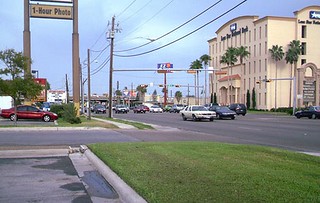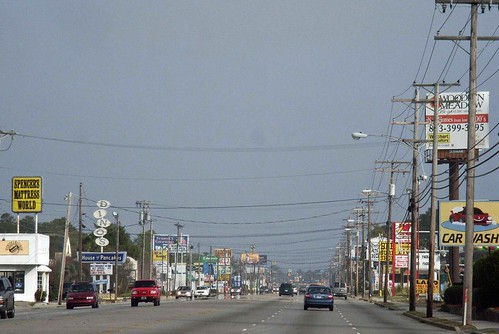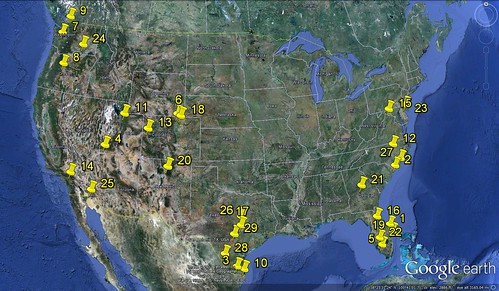Where sprawl still rules

Posted April 11, 2013 at 1:38PM
For several years now, many of us have been predicting - or even celebrating - the end of the era of unfettered sprawl. Central cities have been making a comeback; car ownership is down among young adults; in some places, exurban greenfield land recently designated for residential development has even reverted to farming.
I just took a look at a newish database, and all that seems to be mostly true. But not entirely. The good news is that, in an overwhelming majority of US metropolitan areas, well more than half new construction is taking place in infill locations or as redevelopment of already-built sites. The not-so-good news, though, is that sprawl still dominates new construction in emerging metro regions in certain parts of the country: a counter-trend, if you will, to the main trend.
The pattern of the counter-trend is fascinating: The places in America where sprawl remains the predominant building pattern are not the spread-out icons of Phoenix, Las Vegas, Atlanta, and the like. Instead, they are small and medium-size regions in South Atlantic states (particularly Florida), in Texas and the southern Rockies and, perhaps surprisingly, in pockets of the Pacific Northwest. Instead of Phoenix, think Yuma; instead of Las Vegas, think Provo; instead of Atlanta, think Warner Robins.
Real estate analyst Chris (Arthur C.) Nelson compiled a massive amount of underlying information while researching his latest book, Reshaping Metropolitan America. To say that his database contains a lot of detail is quite the understatement:
Reshaping Metropolitan America: Development Trends and Opportunities to 2030, includes an extensive Excel database of the US population, age and dependency ratios, household size and population, household type, householder age, housing tenure, housing units, space-occupying jobs and non-residential space, and the Reshape America Index. These numbers are included at the level of the nation, census regions and divisions, states including DC, combined statistical areas, metropolitan statistical areas, and micropolitcan statistical areas—a total of 1,132 geographic units. The database includes more than 200 numbers for each geographic unit, which are coded based on census protocols.
 The book’s main point is one that Nelson and others have been making very persuasively for years: Unless we change our building patterns, we are about to be significantly oversupplied (relative to future demand) in large-lot housing and significantly undersupplied in more walkable, urban forms. This is due to shifting demographics and a host of related factors.
The book’s main point is one that Nelson and others have been making very persuasively for years: Unless we change our building patterns, we are about to be significantly oversupplied (relative to future demand) in large-lot housing and significantly undersupplied in more walkable, urban forms. This is due to shifting demographics and a host of related factors.
But I already knew that. I was at a meeting in 2005 where Nelson actually predicted the burst of the housing bubble that caught all the rest of us by surprise two years later, sending the world’s economy into a tailspin. So I’ve been paying close attention ever since.
What caught my eye was a column in the database titled “Percent of Net New Space in Non Infill or Redevelopment Locations.” This column showed, for each of the 1,132 geographic units, the share of new construction claimed by greenfield development beyond the reach of the region's existing development footprint. I wasn’t about to look at every single item in the database, but I did look at this category for the 381 metropolitan areas recognized by the US government.
The data appear to confirm, for the vast majority of US metros, that builders have already shifted to infill and redevelopment to a large extent. But I was curious to learn about the outliers. Where does sprawl still rule the development game? Below are the 29 metro areas - and there are only 29, unless my late-night reading missed one or two - where development beyond the existing footprint comprises 40 percent or more of the total. I ranked them:
- Palm Coast, FL - 83%
- Myrtle Beach, SC - 66%
- McAllen-Edinburg-Mission, TX – 65%
- St George, UT – 63%
- Naples-Marco Island, FL – 58%
- Fort Collins, CO – 57%
- Olympia, WA – 56%
- Bend, OR – 55%
- Bellingham, WA – 54%
- Brownsville, TX – 53%
- Provo, UT – 53%
- Raleigh-Cary, NC – 53%
- Grand Junction, CO – 52%
- Riverside-San Bernardino, CA – 52%
- Winchester, VA-WV – 52%
- Ocala, FL – 49%
- Austin, TX – 48%
- Greeley, CO – 48%
- Port St Lucie, FL – 47%
- Santa Fe, NM – 45%
- Warner Robins, GA – 45%
- Punta Gorda, FL – 44%
- Dover, DE – 43%
- Kennewick-Pasco-Richland, WA - 43%
- Yuma, AZ – 43%
- Killeen-Temple-Fort Hood, TX – 42%
- Wilmington, NC – 42%
- Laredo – 41%
- San Antonio – 40%
As you can see from the maps accompanying this article, there is a clear geographic distribution to these places, and a generally prevailing size, too. Of the 29, only a few have a metropolitan population exceeding a million residents:  Riverside, Raleigh, San Antonio, Austin. I researched the populations of the top ten, which ranged from a low of about 162,000 (Bend) to a high of about 800,000 (McAllen). I confess that I did not know all of the names on the list. But the fact that infill construction and redevelopment constitute a strong majority of the total in over 90 percent of US metro areas is significant.
Riverside, Raleigh, San Antonio, Austin. I researched the populations of the top ten, which ranged from a low of about 162,000 (Bend) to a high of about 800,000 (McAllen). I confess that I did not know all of the names on the list. But the fact that infill construction and redevelopment constitute a strong majority of the total in over 90 percent of US metro areas is significant.
The conclusions, of course, beg some important questions, particularly the definitions of infill and redevelopment (they must be generous) and how Nelson was able to ascertain which increments of construction met the definition. I’m also curious about the time span from which the construction data were taken. Perhaps the answers are in Nelson's book, which I have not been able (yet) to read in depth.
Whatever the fine details, I suspect the conclusions are absolutely correct with regard to the general direction in which the industry is moving – shifting practices to more urban forms, in response to increasingly clear market signals. But not necessarily, particularly in certain parts of the country.
Related posts:
- New DC data confirm real estate recovery strongest in central & transit-served locations (March 26, 2013)
- Why smarter land use can help cities attract and retain young adults (February 1, 2013)
- New housing forecast mostly good for walkable communities (May 17, 2012)
- How the evolving housing market will help sustainable communities (April 4, 2012)
Move your cursor over the images for credit information.



